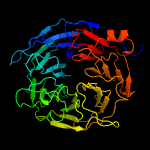
Photo from wikipedia
AIM To retrospectively identify clinicopathological and radiological characteristics that could be independent predictors of epidermal growth factor receptor (EGFR) exon 19 and 21 mutation in surgically resected lung adenocarcinomas in… Click to show full abstract
AIM To retrospectively identify clinicopathological and radiological characteristics that could be independent predictors of epidermal growth factor receptor (EGFR) exon 19 and 21 mutation in surgically resected lung adenocarcinomas in a cohort of Asian patients. MATERIALS AND METHODS Demographics, histopathology data, and preoperative chest computed tomography (CT) images were evaluated retrospectively in 471 surgically resected lung adenocarcinomas. A total of 24 CT descriptors were assessed. Univariate analyses and multivariate logistic regression analyses were performed to identify independent predicted factors of harbouring EGFR mutations. RESULTS EGFR mutations were existed in 252 (53.5%) of 471 patients, and associated with 11 clinicoradiological features. For the model with both clinical and radiological features, the independent predictors of harbouring EGFR mutation were small maximum diameter (≤3.9 cm), non-smokers, micropapillary pattern, pleural retraction, vascular convergence, and absence of solid pattern. The area under the receiver operating characteristic (ROC) curve (AUC) was 0.784. Multivariable logistic regression analysis indicated that non-smokers, vascular convergence, and absence of solid pattern were important independent predictors of EGFR exon 19 mutation, while non-smokers and vascular convergence were independent predictors of EGFR exon 21 mutation. The AUCs were 0.807 and 0.794, respectively. A lepidic growth pattern appeared more frequently in exon 21 mutant tumours than in exon 19 mutant group (p<0.001). CONCLUSION CT imaging features of lung adenocarcinomas in combination with clinical variables could be used to prognosticate EGFR mutation status. The separate analysis of EGFR exon 19 or 21 mutation could further improve diagnostic performance.
Journal Title: Clinical radiology
Year Published: 2019
Link to full text (if available)
Share on Social Media: Sign Up to like & get
recommendations!